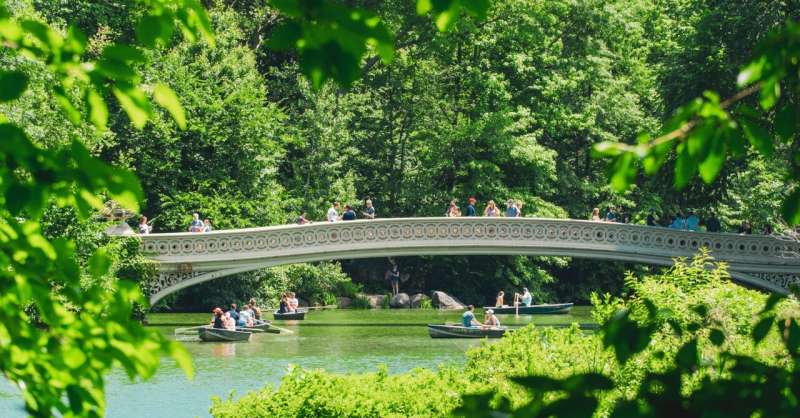The 25 happiest US city park systems, ranked by scientists

Feeling unhappy? Go find a city park—the bigger the better—and try taking a walk outdoors.
That's the upshot of a major new study that measures the happiness effects of city parks in the 25 largest U.S. cities, from New York City to Los Angeles.
The happiness benefit of urban nature on users was so strong—the team of University of Vermont scientists discovered—it was roughly equivalent to the mood spike people experience on holidays like Thanksgiving or New Year's Day.
The research is the largest study of its kind—using massive amounts of data from social media—to quantify the mood boosting benefits on urban nature. It was published March 30 by PLOS One.
"These new findings underscore just how essential nature is for our mental and physical health," says University of Vermont scientist Taylor Ricketts. "These results are especially timely given our increased reliance on urban natural areas during the COVID pandemic."
New way to measure happiness
The study builds on the team's landmark San Francisco research, which used unlikely tools—Twitter posts and geolocation data—to create an effective method to quantify the happiness benefit that people get from nature.
The new study expanded the focus to the 25 largest American cities by population. The team analyzed a whopping 1.5 million Twitter posts to measure differences in online sentiment, comparing tweets posted inside city parks to those posted elsewhere.
The happiest place on Twitter? The great outdoors
Researchers found a powerful happiness benefit from city parks, which was present across all seasons, months, weeks, days, and times of the day—not just weekends and summer holidays.
"We understand the irony of using Twitter and technology to measure happiness from nature," says lead author and recent UVM Ph.D. student Aaron Schwartz, noting Twitter's reputation for 'doom-scrolling.' "But our goal is to use technology for the greater good—to better understand the effect nature has on humans, which until now has been difficult to quantify in such large numbers."
Given the findings, the researchers argue that urban nature should be protected, expanded, and made as accessible as possible. City parks are the primary source of nature for millions of people, they add.
Whose parks make them happiest?
Researchers found that U.S. cities differed a lot in the size of the happiness benefit that their parks provided to users:
- Indianapolis
- Austin
- Los Angeles
- Jacksonville
- Chicago
- Dallas
- Memphis
- Denver
- New York
- San Diego
- San Francisco
- Philadelphia
- Phoenix
- San Jose
- Detroit
- Seattle
- San Antonio
- Houston
- Fort Worth
- Washington
- Columbus
- Charlotte
- Boston
- El Paso
- Baltimore
Some surprises
Scientists were surprised by several top ranked cities in the study—including Indianapolis, Austin and Jacksonville—which have lower per capita funding levels for parks compared to some other cities on the list.
While people wrote far happier tweets in parks—words like "beautiful," "fun," "enjoying," and "amazing"—these top ranked cities saw people write dramatically fewer negative words on Twitter in parks—such as "hate," "don't," and "not."
A more powerful predictor of happiness than park funding per capita (which previous research by others had suggested would be key) was park size. The happiness benefit was highest in parks over 100 acres in area, followed by parks 1 to 10 acres in size.
"Being in nature offers restorative benefits not available for purchase in a store, or downloadable on a screen," says UVM's Chris Danforth, a mathematics professor and Gund Fellow. "However, not all parks appear to be equal when it comes to happiness. The ability to immerse yourself in a larger, greener natural areas had a greater effect than smaller paved city parks."
"One possible explanation," the researchers write, "is that larger parks provide greater opportunities for mental restoration and separation from the taxing environment of the city."
This study brought together multiple UVM research groups, including the Gund Institute for Environment, Vermont Advanced Computing Center, The Spatial Analysis Lab, the MassMutual Center of Excellence in Complex Systems and Data Science, and the Hedonometer, an effort to measure global happiness using Twitter.
More information: Gauging the happiness benefit of US urban parks through Twitter, PLoS ONE (2022). DOI: 10.1371/journal.pone.0261056
Journal information: PLoS ONE
Provided by University of Vermont




















